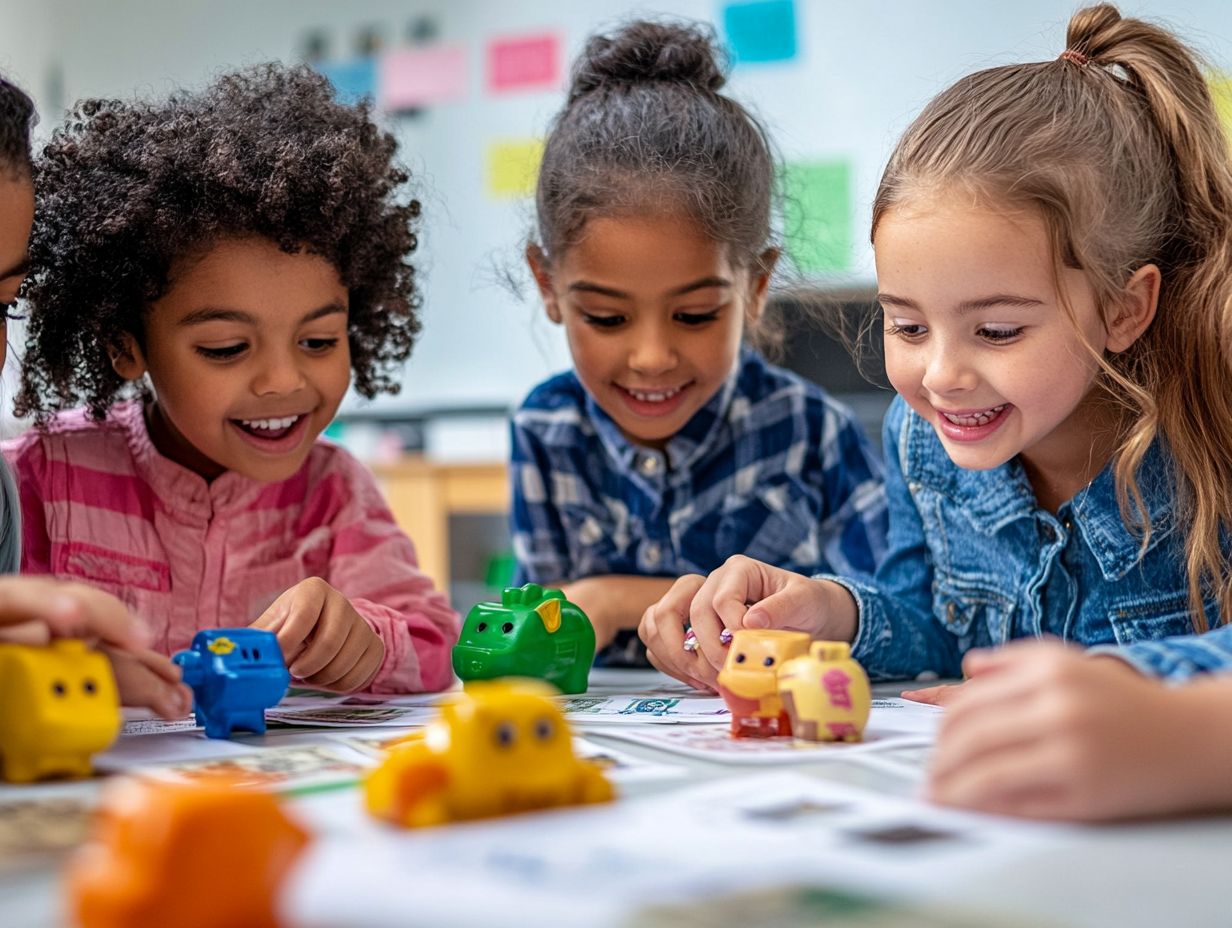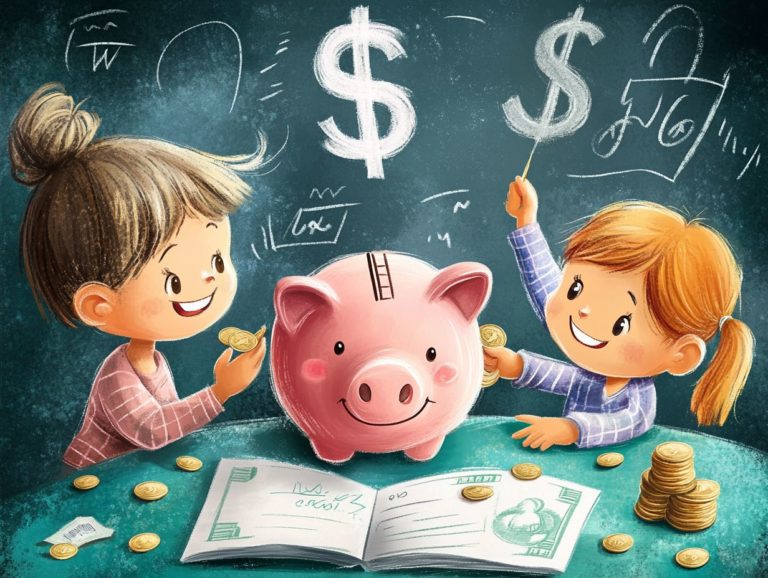What Resources Help Kids Learn About Banks and Checking Accounts?

Neale Godfrey is the financial voice for women and multi-generations and a world-renowned speaker and author, who has inspired millions through her work. She motivates, trains, educates, and frankly, entertains by delivering her core message: Empower yourself to take control of your financial life.
Understanding financial literacy is essential for children, as it gives them the skills they need for a safe and successful life.
This discussion explores the significance of teaching kids about banks and checking accounts, highlighting the benefits they gain from early financial education.
From handling an account to fixing usual misunderstandings, we offer useful resources and practical advice for parents and teachers to use. financial lessons into everyday life, making learning about money enjoyable and simple to grasp.
Key Takeaways:
Why is Financial Literacy Important for Kids?

It’s important to teach kids about money because it helps them handle their finances, make good choices, and see why saving is important.
Understanding how to manage money is very important for reaching goals. Children should learn to know the difference between needs and wants, use money wisely, and set savings goals that will help them later.
This basic knowledge will help them become good shoppers and responsible adults, letting them handle money with confidence as they age. A recent analysis from CNBC suggests that providing kids with an early financial education pays off significantly in the future, aligning well with these foundational lessons. How Do Allowances Teach Kids Financial Responsibility? is an excellent resource to start with if you are wondering how to introduce these concepts.
What Are Banks and Checking Accounts?
Banks are financial institutions that offer various services, such as managing checking accounts, providing debit cards, and handling ATM transactions. According to Investopedia, understanding how banks work can help individuals make informed decisions about which type of bank best suits their needs.
A checking account is a basic financial tool that lets people deposit money, withdraw funds, and monitor their spending through bank statements. Knowing how these accounts work is important for online banking and managing money, as they often include features like overdraft protection to stop accidental overdrafts. For parents considering financial literacy for their children, understanding the framework of youth banking networks (our Youth Banking Network: Purpose and Benefits) can provide additional insights into managing finances from an early age.
What Are the Benefits of Teaching Kids About Banks and Checking Accounts?
Teaching kids about banks and checking accounts has many benefits that provide a foundation for learning about money.
By learning how to manage money through these institutions, children can gain important skills like budgeting, saving, and making wise financial decisions. Understanding these principles early on can be enhanced through structured learning experiences- if interested, explore Financial Literacy for Kids: Benefits and Activities which offers practical ways to engage children.
Knowing how checking accounts and savings operate helps people develop good financial habits and gets them ready for chances such as starting businesses and handling money well.
What Skills Do Kids Learn from Managing a Checking Account?
A checking account helps kids learn simple skills for handling money and managing their budget. Through regular transactions, they learn to track their spending habits, create and adhere to a budget, and understand the importance of reviewing their bank statements. These experiences help them develop responsibility and accountability, getting them ready for managing money later.
By handling their account, young people understand their financial status and make wise decisions about their money.
Learning how to budget helps them focus on what is necessary rather than on what they desire, while monitoring their expenses provides a clear view of how they spend their money each month.
Regularly reviewing bank statements deepens their comprehension of financial documents, a critical aspect of adult life.
These basic skills help children manage money well and teach them to make good financial decisions as they grow, preparing them to be knowledgeable adults about finances.
How Can Teaching Kids about Banks and Checking Accounts Benefit Them Later in Life?
Teaching kids about banks and checking accounts gives them a solid base for handling money well later in life, helping them understand how to manage financial systems.
As they grow, this knowledge becomes important, helping them make key choices about investments, loans, and other financial products with confidence.
Engaging with concepts like interest rates and budgeting can help them grasp how their choices today can affect their economic stability in the long run.
A strong grasp of financial literacy encourages them to participate actively in their communities, whether through informed consumer behavior or supporting local businesses. For those interested in a comprehensive overview, this analysis by Investopedia covers the full spectrum of implications.
In the end, the lasting advantages of this education go beyond individual money management, allowing people to help the economy, motivate others, and possibly start their own businesses.
What Resources are Available to Teach Kids About Banks and Checking Accounts?

There are many tools that can help kids learn about banks and checking accounts, making it enjoyable and simple to grasp financial education.
These tools include online games, interactive learning activities, informative books, and educational materials that help them learn financial concepts. For those interested in exploring more, our guide to the best financial literacy games provides top picks and classroom resources.
Programs like Hands on Banking offer structured financial literacy lessons, while real-life experiences help reinforce these ideas in practical settings.
1. Online Games and Activities
Online games and activities serve as an innovative approach to financial education, engaging children in interactive learning experiences that make complex concepts easier to understand. These games often simulate real-life financial scenarios, helping kids grasp essential financial literacy skills while having fun.
Playing the game helps participants learn about budgeting, saving, investing, and why making careful financial decisions is important.
Games like ‘Adventures in Money Management’ and ‘Financial Football’ teach young players how to use their money skills in various scenarios, helping them to think carefully and solve challenges.
These interactive platforms offer the opportunity for collaboration, allowing kids to discuss strategies and outcomes with peers, reinforcing their learning.
These online games mix technology with financial education to help children learn in various ways and teach them how to manage money wisely as they mature.
2. Books and Educational Materials
Books and educational materials are important for teaching kids about banks and checking accounts, offering useful information on handling money. These materials can cover various topics, from basic money management to detailed information about economic decisions.
They often include interactive workbooks, engaging storybooks, and digital courses that cater to diverse learning styles.
Educators can use these resources in lesson plans to create a complete curriculum that explains concepts like savings and budgeting and encourages students to participate in discussions and practical activities.
For instance, using scenario-based books can help illustrate real-life financial decisions, allowing kids to think critically about their choices.
Parents can help with school learning by using similar materials at home, talking regularly about handling money, and teaching the next generation how to make good financial decisions.
3. Financial Education Programs
Financial education programs, such as Hands on Banking, provide structured learning opportunities for children, focusing on essential financial literacy concepts. These programs often include interactive classroom activities that engage students and encourage practical application of financial skills.
Teaching topics like budgeting, saving, and responsible spending early can greatly help young people manage their money better.
For example, Hands on Banking uses hands-on activities and role-playing to teach children about real-life money situations, making learning enjoyable and relevant. These practical activities help students understand and remember how to handle money details.
These educational programs give young people the essential skills they need to make informed decisions and stay financially stable for life.
4. Real-life Experiences
Real-life situations are important for strengthening kids’ financial knowledge, helping them put their money management lessons into practice. Engaging in activities like budgeting for a family outing or saving for a desired toy helps children understand the real-life implications of their financial decisions.
By involving them in grocery shopping, for instance, parents can teach children how to compare prices, make a shopping list, and stick to a budget.
Teachers can create simulations of real-world scenarios, such as planning a classroom party, where students allocate funds for various supplies.
These practical activities help them think carefully about expenses, improve their budgeting skills, and build habits for saving over time.
Discussing the importance of goals, like setting aside money for a favorite game or a special event, helps impart the value of delayed gratification and wise financial planning.
Such practical lessons lay the groundwork for responsible financial management in adulthood.
How Can Parents and Teachers Teach Financial Skills to Kids?

Parents and teachers play an essential role in teaching kids about money by setting good examples and guiding them in money management.
By demonstrating how to budget well and explaining the importance of saving, adults can help children develop a strong foundation in financial knowledge that benefits them throughout their lives.
Discussing financial decisions and encouraging responsible money habits can create an environment supportive of financial education at home and in school.
1. Setting a Good Example
Setting a good example is one of the most effective ways for parents and teachers to instill financial literacy in children. When adults show good money habits-like budgeting, saving, and spending wisely-they can show kids how to handle money well.
When parents involve their children in family budgeting sessions, explaining the importance of allocating funds for different expenses, it becomes a practical lesson in prioritizing needs over wants.
Teachers can further supplement this by incorporating real-life scenarios into classroom discussions, where students analyze case studies of financial success, reinforcing the value of planning and thriftiness.
Modeling behaviors like using cash instead of a credit card can help young learners grasp the concept of living within their means.
These important practices teach basic money management skills, helping young people become financially responsible adults.
2. Starting Early and Making it Fun
Teaching kids about money early and using enjoyable activities can greatly improve their involvement and knowledge of handling finances. Playing games, setting budgeting tasks, and creating saving targets can make learning fun and encourage a good mindset towards learning about money.
For instance, setting up a pretend store where children can use play money to buy and sell items teaches them about transactions and the concept of exchange.
Parents and teachers might organize a ‘savings challenge’ where kids compete to save a designated amount of money over a month, promoting the idea of delayed gratification.
Role-playing situations, such as acting as a banker or a shopkeeper, make learning more engaging by introducing practical examples.
These activities teach children how to make good decisions about money as they grow, and provide them with the basic skills needed to manage their finances later in life.
3. Adding Financial Literacy to Daily Tasks
Adding financial literacy to daily tasks offers important teaching opportunities that strengthen money management skills.
By involving individuals in routine tasks, they can learn essential budgeting lessons in a practical context. For instance, when planning a family outing, setting a budget and comparing different entertainment options can highlight the significance of prioritizing expenses.
Likewise, when buying groceries, checking prices and choosing products according to your budget can help you spend money wisely. Tasks like creating a savings jar can instill the habit of saving over time, encouraging goal-oriented financial thinking.
These typical situations explain why it’s important to handle money carefully and how your choices affect your finances.
4. Encouraging Saving and Budgeting
Teaching kids to save and budget early helps them learn important money skills, supporting financial knowledge. By setting savings goals and explaining how to budget, parents and teachers can help kids learn to manage their money.
This proactive approach helps instill a sense of responsibility and discipline regarding personal finances.
By engaging children in activities like creating a simple budget for their allowance or a piggy bank savings challenge, they can witness firsthand the benefits of financial planning.
Introducing tools like apps designed for young users can make tracking savings both fun and educational.
Talking about the need for emergency savings and long-term investments helps build a strong base for their finances.
Developing these skills helps them handle real-life money issues and promotes careful spending and saving habits.
What Are Some Common Misconceptions About Banks and Checking Accounts?

Even though it’s important to know about banks and checking accounts, some wrong ideas continue that can stop kids from learning about money. These wrong ideas include:
- Thinking banks are only for rich people
- Believing that checking accounts are too hard for young people to use
- Assuming that children don’t need to learn about money until they are older
Clearing up these wrong ideas is important for giving kids the knowledge they need to handle their money well.
1. Banks are Only for Rich People
One common misconception is that banks are only for rich people, which can discourage kids from using banking services. Banks provide essential financial services to individuals from all income levels, assisting everyone regardless of their earnings.
This includes offering basic checking and savings accounts with low or no minimum balance requirements, ensuring that essential banking services are accessible to everyone.
Many financial institutions are committed to promoting financial literacy among all economic backgrounds. Educational programs are available to help individuals understand budgeting, saving, and investing-even for those who may be new to managing finances.
Banks work to make these services widely known to dispel the idea that they are only for a select few, helping young people manage their finances. Knowing the value of banking can help you make better financial choices, leading to greater economic stability over time.
2. Checking Accounts are Complicated and Only for Adults
Another misconception is that checking accounts are complicated and only suitable for adults, which can create barriers to financial literacy for kids. In truth, checking accounts can be simple and beneficial tools for managing money, even for younger users.
By introducing checking accounts early, children can learn the basics of budgeting and saving while experiencing the convenience of digital banking.
For instance, when a child receives an allowance, utilizing a checking account allows them to track their spending, set savings goals, and understand the value of money management.
When parents encourage children to review their bank statements and make good financial decisions, they help develop a generation that knows how to manage money effectively.
These practical activities help young people understand banking ideas and teach them responsibility and accountability.
3. Banks are Not Safe and Can’t Be Trusted
A prevalent misconception is that banks are not safe and cannot be trusted, which can deter kids from utilizing banking services. Banks are regulated institutions that prioritize the safety and security of their customers, ensuring they are reliable for managing finances.
In fact, different regulations like the Federal Deposit Insurance Corporation (FDIC) insurance make sure that deposits are protected up to a certain amount, giving customers reassurance. Banks must adhere to stringent laws designed to safeguard both consumer information and their financial assets.
By helping children learn about these protections, parents can teach them to tell the difference between myths and facts, strengthening the importance of knowing how to manage money. This can help them make informed decisions about their money, building a safer and more trustworthy connection with banks.
4. Kids Don’t Need to Learn About Finances Until They are Older
Many people mistakenly think children should wait until they are older to learn about money, which can prevent them from knowing how finances work. Teaching kids about money from a young age helps them learn how to handle their finances wisely and get ready for financial challenges later in life.
Teaching children about budgeting, saving, and investing early in life gives them skills to make wise choices as adults.
Knowing the importance of money and setting clear financial goals can help improve spending habits and reduce financial stress as time goes on.
Teaching kids about money early helps them deal with real financial tasks, like using bank accounts or learning about credit. This sets them up to manage their money well as they grow up.
Learning about money should start when children are young, so they build the confidence and knowledge they need to handle money well.

Neale Godfrey is the financial voice for women and multi-generations and a world-renowned speaker and author, who has inspired millions through her work. She motivates, trains, educates, and frankly, entertains by delivering her core message: Empower yourself to take control of your financial life.






